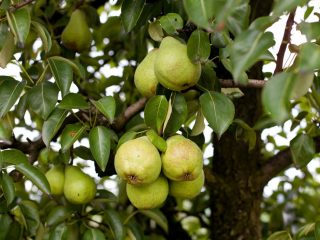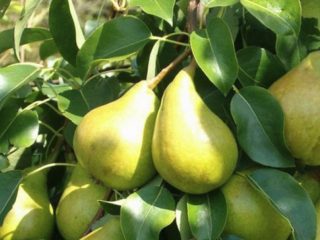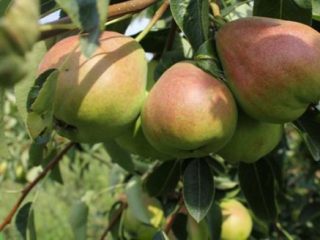Content
Columnar pear is a special type of crop, the existence of which is often questioned. This group includes varieties with certain characteristics. They can be natural or caused by vaccination.
Are there columnar pears?
Opinions about the existence of columnar pears are divided. Some believe that this is the name of ordinary dwarf varieties. Others consider columnar pears separately. They are indeed usually of short height, since they are grafted onto a dwarf rootstock. These varieties are also distinguished by their compact crown and formation strictly into one trunk. The photo of the tree clearly reflects the characteristics of the columnar pear.

A popular representative of the columnar pear is the Dutch variety Night Wert; the trees do not exceed 2 m in height.
Advantages and disadvantages
Gardeners are increasingly choosing columnar crops.Such pears have the following advantages:
- compact size;
- precociousness;
- high yield rates;
- space saving - the planting scheme allows for a small interval between trees;
- easier to harvest.
Columnar varieties also have disadvantages:
- short life expectancy (usually up to 15 years);
- requirement for care.
The best varieties of columnar (dwarf) pears
Gardeners are increasingly choosing columnar crops, which is why breeders are actively working in this direction, developing new varieties. Some representatives of this group have already proven themselves to be the best.
Decor
This columnar variety is a late summer variety. The harvest is harvested in the second half of August. Characteristics of the Decor variety:
- height no more than 2 m;
- the crown is narrow and vertical, but prone to thickening;
- life expectancy 15-20 years;
- pear-shaped fruits 200-250 g;
- uniform yellow-green color of the skin;
- The juicy and tender pulp has a grainy texture;
- pronounced aroma;
- good transportability.
Decora belongs to the sweet varieties of columnar pears. Its fruits are consumed fresh and also used for all types of processing. The variety is also suitable for whole-fruit canning.
Decor brings the first harvests in 2-3 years. Her fruiting is stable. A harvest of up to 20 kg is harvested from the tree.
Decora is a self-fertile crop. At the same time, pollinators are needed for a good harvest. The following varieties are suitable for this purpose:
- Lada;
- In memory of Yakovlev;
- Chizhovskaya.
Pollinators for columnar pears are selected so that the flowering dates coincide.

The columnar variety Decora has low winter hardiness - the tree can withstand up to -20 °C without shelter.
Sapphira
Sapphira belongs to the late varieties of columnar pear. The harvest is harvested in mid-September, and it reaches consumer maturity by October. Main characteristics of the variety:
- height up to 2-3 m;
- the leaf blades are large, round in shape;
- pear-shaped fruits of heterogeneous size - weight from 50 to 350 g;
- the cover color is green, there is a slight yellowness and a pink-burgundy blush on the south side;
- The white flesh has a creamy tint and good juiciness;
- taste sweet and sour;
- frost resistance up to -25 °
The columnar Sapphira pear bears its first harvest in the third year. The tree reaches its maximum performance by 6 years of age. During this period, a harvest of 10-15 kg can be harvested from the tree.
The variety is not suitable for long-term storage. If the fruits are not collected in a timely manner, they will remain on the branches, but the taste will deteriorate.

The columnar variety Sapphira is immune to scab and fire blight.
Carmen
Carmen is a representative of early varieties of columnar pears. It is currently undergoing state testing. To develop a hybrid, Daughter Blankova and Williams Red were crossed. The resulting summer variety has the following characteristics:
- fast growth;
- the crown is compact and narrowly pyramidal with branches extending at an acute angle;
- the color of the shoots is brownish-brown;
- the foliage has a reddish tint, the surface is shiny, the shape of the plates is rounded-elliptical, the size is average;
- short pear-shaped fruits 120-170 g each, some specimens are twice as large;
- dry skin has a burgundy color when picked, and a brownish-red color at the time of consumer maturity;
- subcutaneous points in large numbers;
- The light cream pulp has moderate density, semi-oily texture, and good juiciness;
- the taste is sweet and sour, there is no astringency;
- light aroma.
The columnar Carmen pear reaches removable maturity by mid-August. The variety is summer, so the consumption period is short - up to half a month.
Carmen begins to bear fruit in the fifth year. Its yield and frost resistance are at an average level.
Among the advantages of the columnar variety Carmen is a small-sized crown and full color of the fruit. The compactness of trees allows you to plant more than 1000 of them per 1 hectare.

The disadvantage of the columnar Carmen pear is the slow increase in yield, but the variety is resistant to septoria and scab
Delight
Columnar pear Delight is an autumn variety. The harvest is harvested in early September. Main characteristics:
- small oval-shaped leaves;
- fruits 110-160 g;
- uneven yellow color, subcutaneous spots are often present, rustiness of the skin;
- The juicy pulp has moderate density and oiliness;
- sweet honey taste;
- pronounced aroma;
- universal purpose;
- frost resistance up to -20 °C;
- yield up to 20 kg per tree.
The columnar pear Vostorg is a partially self-fertile variety. Cross pollination is necessary for good yield.

It is recommended to harvest the columnar pear Vostok in several stages as it ripens - this approach increases the shelf life of the fruit
How to grow a columnar pear
Columnar pears are planted both in spring and autumn. The first option is recommended for colder regions. Spring planting provides time for successful rooting, adaptation and preparation for winter. Work is planned for March-April. Autumn planting is carried out until October, before frost sets in.
For the successful growth and development of a columnar pear, it is important to choose the right site:
- fertile soil;
- good air and moisture permeability of the soil;
- protection from strong winds and drafts;
- good lighting;
- no stagnation of water.
For planting, it is better to choose annual seedlings of columnar pears. Be sure to inspect them. Mechanical damage and signs of disease are not allowed. The root system should not be dry.
The planting pit is prepared in advance. The optimal depth is 0.8 m, the diameter is 20 cm less. A bucket of water is poured into the dug hole, and after it is completely absorbed, humus and sifted sand are added. Fertile soil is mixed with 0.2 kg of superphosphate and 100 g of potassium sulfate. A third of the resulting volume is used to make a mound in the pit. After five days, a bucket of water is poured in again.
Before planting, it is recommended to place the seedling in a bucket of water for at least eight hours. The further algorithm is as follows:
- Install a support.
- Place the seedling on the embankment, spreading out the roots.
- Fill the hole so that the root collar is level with the surface.
- Compact the ground.
- Water the tree generously.
The planting pattern depends on the variety. Leave at least 0.5-1 m between trees.
How to care for columnar pear
Caring for a columnar pear should be comprehensive.The main activities are standard, among them watering and tree formation are especially important.
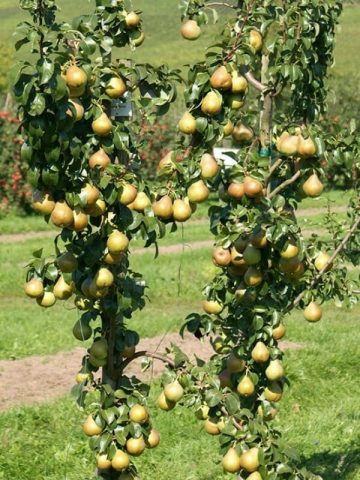
In case of a bountiful harvest, rationing is carried out to increase the size of the fruit.
Pruning and shaping the crown of a columnar pear
Be sure to form a columnar pear. The process begins in the second year of growing the tree. Leave 1 central conductor and make sure that the apical bud is healthy and intact. When it is damaged, additional shoots begin to grow. In this case, the strongest one is left and the rest are removed.
It is better to prune columnar pears in April or August. The central conductor is shortened by 15 cm in the spring, and long shoots by a third in the fall.
A mandatory measure is sanitary pruning of the columnar pear. It should touch branches that:
- damaged;
- withered;
- sick;
- frozen.
If the central conductor develops poorly, it is cut off. Leave 2-3 buds. Anti-aging pruning begins at the age of 7-8 years.
If the columnar pear blooms in the first year after planting, the buds should be cut off. This will improve the growth and development of the tree. The inflorescences are also removed next year, but not all. It is enough to leave 4-5 fruits.
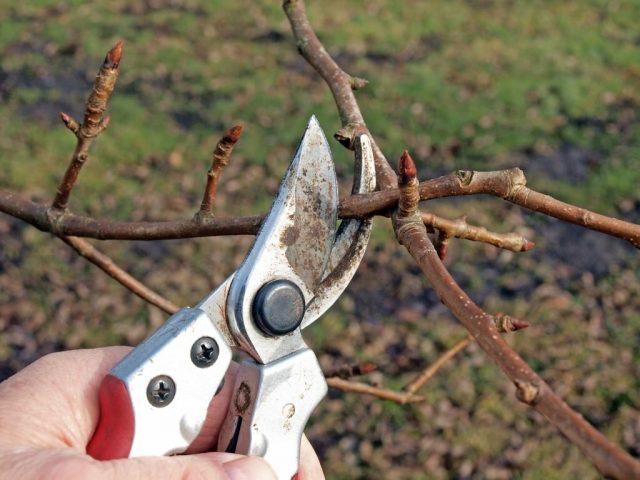
In the spring, before the sap flows, cut off all the side branches growing to the sides, leaving two buds
Watering
The columnar pear must be watered. Moisturizing is especially important after planting while the tree is taking root. During this period, watering is carried out 3-4 times a week. To preserve moisture, they resort to mulching.
For watering, a small depression is formed around the perimeter of the tree trunk circle. Water is poured into it, and not on the tree.
Feeding columnar pear
If you prepare the planting hole correctly, then fertilizers will be applied next time only in the second year of cultivation. When feeding columnar pears, it is important to alternate organic and mineral compositions.
In the spring, a single application of humus is recommended, but not more than once every 2-3 years. This feeding is combined with loosening. From organic matter, slurry and chicken manure are also used.
During the season, mineral complexes based on potassium and phosphorus are used. In spring, nitrogen - saltpeter or urea - is appropriate. The latter is diluted in water at the rate of 5 g per 1 liter. Fertilizing with urea is carried out three times:
- when the first leaves appear;
- after two weeks;
- in another month.
Preparing for winter
Preparations for winter begin with removing garbage and plant debris. Work begins after leaf fall.
Many columnar varieties do not have such high frost resistance, so shelter is required for the winter. Insulation is organized when the temperature drops to -10 °C.
Columnar pears can be covered with burlap or other suitable material, securing it securely. Suitable for protecting the tree trunk:
- sawdust;
- straw;
- spruce paws.
The trunk is protected from rodents with roofing material. Spruce paws are also suitable for this.
Another option is a frame shelter. The base is made of wood. Dry leaves or humus are poured inside. Pine needles and straw are also suitable. For additional insulation, agrofiber or other suitable material is used, securely fixing it.

Trees up to three years old are covered together with the apical bud
Reproduction methods
The most effective way to propagate columnar pears is grafting. It ensures good tree growth. An ordinary pear and quince are used as a rootstock.
The crop can be propagated by seeds, but this process is very long and labor-intensive. A faster result will be obtained by cuttings. Use blanks with at least five sheets. They are treated with a root-forming preparation, then added dropwise.
Disease Prevention
Caring for a dwarf pear involves preventing diseases and pests, although columnar varieties usually have good immunity. The following events are important:
- spring and autumn whitewashing of trunks, skeletal branches - copper sulfate is added to the solution, a brush is used for application;
- elimination of exfoliated areas of bark with stripping to healthy tissue and disinfection;
- timely harvesting of crops, plant residues, fallen fruits;
- sanitary pruning;
- autumn cleaning and burning of leaves;
- mineral fertilizing subject to substance application standards.
To prevent scab, columnar pears are sprayed with Bordeaux mixture or urea in the spring. To treat and prevent fungal diseases, fungicides are used:
- Bordeaux mixture;
- Raek;
- Fitosporin-M;
- Horus.
Prevention is especially important in March-April, when crops are more vulnerable to fungi.
Conclusion
The columnar pear is valued for its small tree height and compact crown. Such varieties are more demanding of care and have a short life expectancy, but they are early-bearing and have good immunity.
Reviews from gardeners about columnar pears



